Comptroller Kevin Lembo Archive > News
COMPTROLLER LEMBO PROJECTS $101.2-MILLION DEFICIT FOR FISCAL YEAR 15 DUE TO LOWER ESTIMATED INCOME TAX COLLECTIONSIn a letter to Gov. Dannel P. Malloy, Lembo said his projection is an increase in the Office of Policy and Management's (OPM) most recent deficit by $40 million as a result of lower estimated income tax collections.
Lembo said a federal change in capital gains rates significantly altered estimated and final income tax receipts in Fiscal Years 2013 and 2014. Taxpayers shifted gains that were likely to occur in Fiscal Year 2014 to Fiscal Year 2013 in order to take advantage of the lower tax rates in place at that time.
While the Office of Policy and Management (OPM) has reported anticipating a rebound, Lembo said he is not confident that the level of anticipated increase will be attained. Estimated income tax payments through January have grown 4.9 percent over last year.
"In the past, these payments through January have provided an indication of the size of estimated and final payment receipts that can be expected in April," Lembo said. "The OPM projection relies on a 20-percent variance between January and April. An increase of this scope has not occurred in the last decade.
"I am also concerned that since the stock market recovery began in 2009, trading volume that generates taxable receipts has been declining. It appears that one cause is an aging demographic that has shifted to lower risk portfolios with less trading volume. Complicating matters further, volume has been heaviest at lower points in the market cycle, thus reducing the amount of taxable capital gains. For these reasons, I have reduced my income tax estimate by $40 million this month. I remain hopeful that April receipts will outpace my current projection, but I believe it is reasonable to lower expectations at this time."
"As I noted last month, based on current spending trends and realized lapses over the past five fiscal years, I believe that the OPM savings target for the General Fund that now totals $276.8 million is attainable," Lembo said. "Over the past five fiscal years, annual realized lapses have averaged $511.2 million. Although the current lapse target is a significant challenge, it is not inconsistent with past performance in difficult budget circumstances.
"It should be noted that in past years legislative action has been required in many instances to attain the required savings level."
As far as economic indicators, updated state employment information for January will be available on March 16. In the meantime, the latest economic indicators from federal and state Departments of Labor and other sources show:

• Through the first seven months of Fiscal Year 2015, the
withholding tax trend was running 3.4 percent above the same period last year.
This is a deceleration in the growth rate from last month when the year-to-date
results were up 4.5 percent. Monthly withholding receipts tend to be volatile
due to the timing of payroll disbursements.
• Withholding receipts have yet to attain the pre-recession growth rates. The
large revenue increases in Fiscal Years 2011 and 2012 were almost entirely
attributable to higher income tax rates. Net of those tax increases, withholding
receipts were stagnant in both Fiscal Year 2011 and Fiscal Year 2012. The poor
performance also continued through Fiscal Year 2013. In Fiscal Year 2015, the
consistent growth in employment is beginning to produce stable growth in the
withholding receipts.
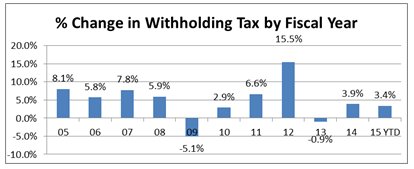
• The Department of Labor releases January employment numbers on March 16. Accordingly, the December numbers are presented again this month. The graph below depicts the stabilization of job growth in Connecticut going into the second half of Fiscal Year 2014 and continuing in Fiscal Year 2015. The state has gained jobs in 10 of the last 11 months. December's preliminary gain totaled 4,800 payroll positions.
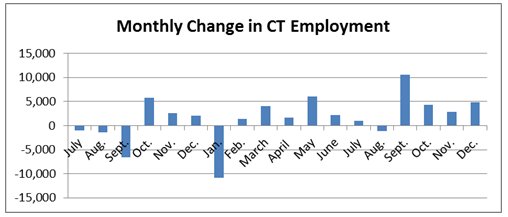
• Connecticut has now recovered 96,300 positions, or 80.9
percent of the 119,100 seasonally adjusted jobs that were lost in the state
during the March 2008 - February 2010 employment recession. Connecticut's jobs
recovery is now 58 months old and is averaging approximately 1,660 jobs per
month since February 2010.
• The table below shows the distribution of employment gains and losses by major
employment sector over the latest twelve month period ending in December.
• Job additions in Connecticut during this period total 26,700.
| Job Gains Latest 12 Months | Job Losses Latest 12 Months | ||
|---|---|---|---|
| Sector | Sector | ||
| Transp. & Public Utility | 7,700 | Financial Activities | -2,400 |
| Leisure & Hospitality | 6,400 | ||
| Education & Health Svc | 5,600 | ||
| Prof. & Business Svc | 4,800 | ||
| Manufacturing | 1,900 | ||
| Government | 1,000 | ||
| Construction | 800 | ||
| Other Services | 700 | ||
| Information | 200 |
• U.S. employment has been advancing at a rate of 2.1 percent
over the 12-month period ending in December; Connecticut's employment growth was
1.6 percent for the same period.
• Connecticut's unemployment rate was 6.4 percent in December; the national
unemployment rate was 5.6 percent. Connecticut's unemployment rate has continued
to decline from a high of 9.5 percent in October 2010.
• There are approximately 121,400 unemployed workers in Connecticut. A low of
36,500 unemployed workers was recorded in October of 2000. The number of
unemployed state workers hit a recessionary high of 181,300.
![]()
• The Department of Labor calculates that Connecticut's
average hourly earnings rose 39 cents to $28.42, an increase of 1.4%, from last
December 2013. The resulting average private sector weekly pay was calculated at
$960.60, up $18.79, or 2.0% over the year. This is below the strong wage growth
recorded in November.
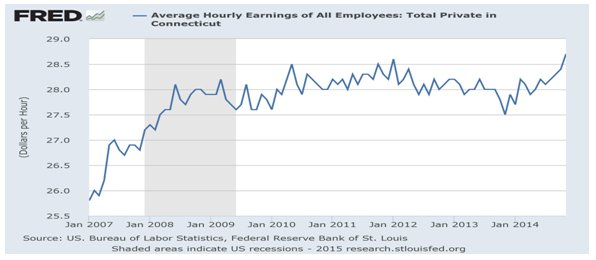
• Based on data released by the Bureau of Economic Analysis
on Dec. 19 for the 3rd quarter of 2014, personal income in Connecticut grew at
an annualized rate of approximately 4 percent, down from the 5.2-percent rate of
increase in the 2nd quarter of 2014. Connecticut was ranked 18th nationally in
personal income growth for the quarter. Fourth quarter results will be released
on March 25.
• The chart below shows the annual trend in Connecticut personal income over
time. The 2014 estimate is based on annualizing 3rd quarter results.
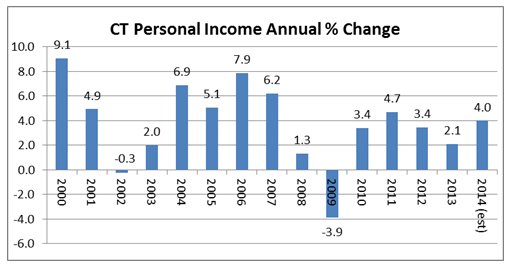

• The Real Estate Conveyance Tax is trending almost 6 percent ahead of
collections through December of last year.
• According to a report from the Warren Group released on February 17,
single-family home sales in Connecticut for December rose 1.7 percent from
December of last. This is the fourth consecutive month of year-over-year
increases. The median price of a single-family home fell 2.1 percent to $240,000
in December, down from $245,000 a year earlier. December marked the tenth
consecutive month that sales prices have decreased year-over-year.
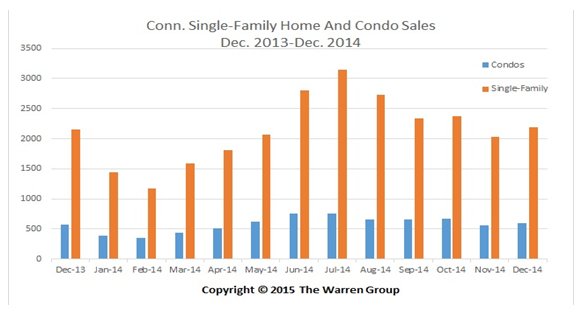
• The National Association of Realtors reported that existing U.S. home sales in January were up 3.2 percent from the same month last year and prices were up 6 percent to $199,600.
Consumers
• Sales tax receipts through January of Fiscal Year 2015 were somewhat sluggish
after rising at a year-to-date pace of 4.5 percent through October. At present,
the sales tax is expected to exceed the initial budget projection $58.8 million.
• Advance retail sales were up 3.3 percent for the 12-month period ending in
January. This is down from December's 4-percent growth pace. With the exception
of gasoline stations, all business sectors experienced growth. Car sales
continued to lead with gains in excess of 10 percent.
• According to the Conference Board, consumer confidence fell back in February
after a January that had attained the highest reading since August of 2007. The
February reading was the lowest since September 2014.
• The Federal Reserve reported that consumer credit increased 5.4 percent in
December after posting a November gain of 4.9 percent. In a reversal of recent
trend, revolving credit such as credit card debt grew 7.9 percent while
non-revolving credit such as car loans advanced 4.5 percent.
Business and Economic Growth
• Based on the Feb. 27 second estimate by the Bureau of
Economic Analysis, real GDP increased at a rate of 2.2 percent in the 4th
quarter of 2014. In the 3rd quarter of 2014 real GDP increased at a 5-percent
rate.
• The increase in real GDP in the 4th quarter reflected positive contributions
from personal consumption expenditures (PCE), private inventory investment,
exports, nonresidential fixed investment, state and local government spending,
and residential fixed investment that were partly offset by a negative
contribution from federal government spending. Imports, which are a subtraction
in the calculation of GDP, increased.
• In the 3nd quarter, U.S. corporate profits posted a 3.1-percent gain from the
3rd quarter. The 2nd quarter had posted a stronger 8.4-percent rise in profits.
Profits were up 1.4 percent from the 3rd quarter one year ago.
• The Department of Labor's General Drift Indicators are composite measures of
the four-quarter change in three coincident (Connecticut Manufacturing
Production Index, nonfarm employment, and real personal income) and four leading
(housing permits, manufacturing average weekly hours, Hartford help-wanted
advertising, and initial unemployment claims) economic variables, and are
indexed so 1986 = 100. The index has been showing a general upward trend
although it remains well below pre-recession levels.
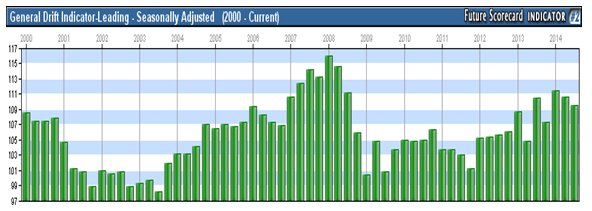
Stock Market
• Estimated income tax payments, which are influenced by capital gains receipts, were trending 4.9 percent higher thru January from the same period one year ago. The chart below shows the trends in estimated and final income tax payments since 2005. For Fiscal Year 2015, only a small portion of the final payments have been processed to date. Most final payment activity occurs in April.
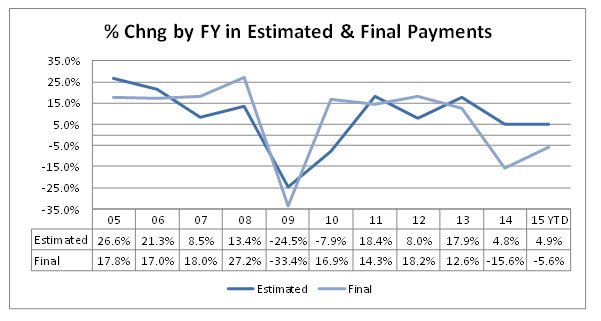
• As depicted below, while the market has been recovering
since 2009, trading volume has been declining. The drop in trading volume is
associated with lower individual investor/retail investor market activity. One
theory for this phenomenon is an aging demographic that has moved into lower
risk portfolios with less trading activity such as index funds. Volume has also
been heaviest at lower points in the market cycle. These factors can have a
negative impact on state capital gains related tax receipts.
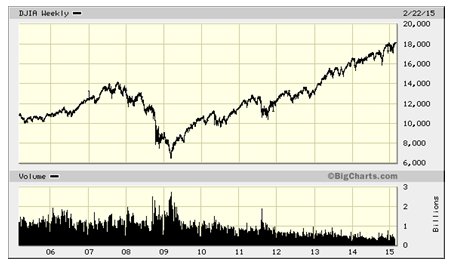
***END***
